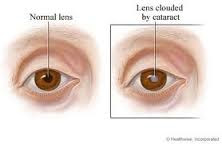Eye lens is a transparent section in the back of the pupil (the black spot in the center of the eye) that serves to focus light on the retina. In the presence of a cataract, light entering the eye becomes blocked. Cataracts usually occur when a person enters old age.
Eventually a cataract condition will be increased so as to obstruct vision. Many sufferers are eventually require surgery to replace the damaged lens with an artificial lens.
Causes Cataracts in Elderly
The cause of cataract is not known with certainty. Along with age, the proteins that make up the eye lens ever changing. This makes the lens of the eye that had been clear, changed into murky. Until now, not yet known how the aging process can lead to changes in proteins in the eye lens.
Some other factors that will heighten your risk of developing cataracts:
- Eye exposure to sunlight for a long time.
- Some health conditions such as diabetes or inflammation of the middle part of the eye (uveitis) long term.
- Taking high doses of corticosteroid medications for a long time.
- Had undergone eye surgery.
- Or a family history of cataracts in the offspring.
- Unhealthy diet and lack of vitamins.
- Consumption of liquor in large quantities on a regular basis
- Smoke
Things that Can be Symptoms of Cataracts
Cataracts often affects both eyes, although the level of both conditions can be different. This disease can develop over many years without being felt by the sufferer.
Cataracts do not cause pain or irritation. Patients usually will experience vision vague and foggy, otherwise it will appear spots or blotches when eyesight is less clear.
Cataracts can also affect your view in the following ways:
- The eyes are sensitive to glare.
- Difficult to see when the light is dim or very bright.
- All became visible double.
- All look like have a tinge of yellow or brown.
- The size of eyeglass lenses that change.
- You like seeing halos around bright light, such as car headlights or streetlights.
- Color vision faded or are not clear.
Consult with Optical Dispensers
Consult with optical dispensers (expert eyeglass lenses) if you feel there is a problem that your eyesight can be checked. If there are sudden changes in your eyesight, immediately do an eye exam.
Optical dispensers will examine the eye with an ophthalmoscope. This tool will clarify eyes look bright and emit light so that the optical dispensers can see the inside of the eye, including the lens check the condition of your eyes.
If there is a cataract, it is advisable to consult with an ophthalmologist who can provide a diagnosis and plan your treatment process.
Cataract Treatment In Elderly Through Operation Process
Glasses and brighter lights might help cataracts are mild, but the cataracts will evolve over time and eventually patients will require surgery.
The only measures that have proven most effective treatment is surgery. The healing effects of the operation will be felt mainly for cataract patients who already hamper everyday activities, such as driving or reading.
In cataract surgery, the cloudy lens will be removed and replaced with a clear plastic lens. The operation is usually performed under local anesthetic so that your eyes become numb. Because of this, including minor surgery, it is usually no need to stay in the hospital.
Although the recovery from surgery will take some time (from several days to weeks), almost all the people who live it will feel improvement in their vision. Patients are usually able to resume normal routine within two weeks after surgery.
Plastic lenses in your eyes adjusted to the level of a certain vision. After opersi, the use of glasses will be needed to help the vision is far or near. Similarly, if you have glasses, lens size can be changed. It is advisable to wait until the recovery is complete before making new glasses.






